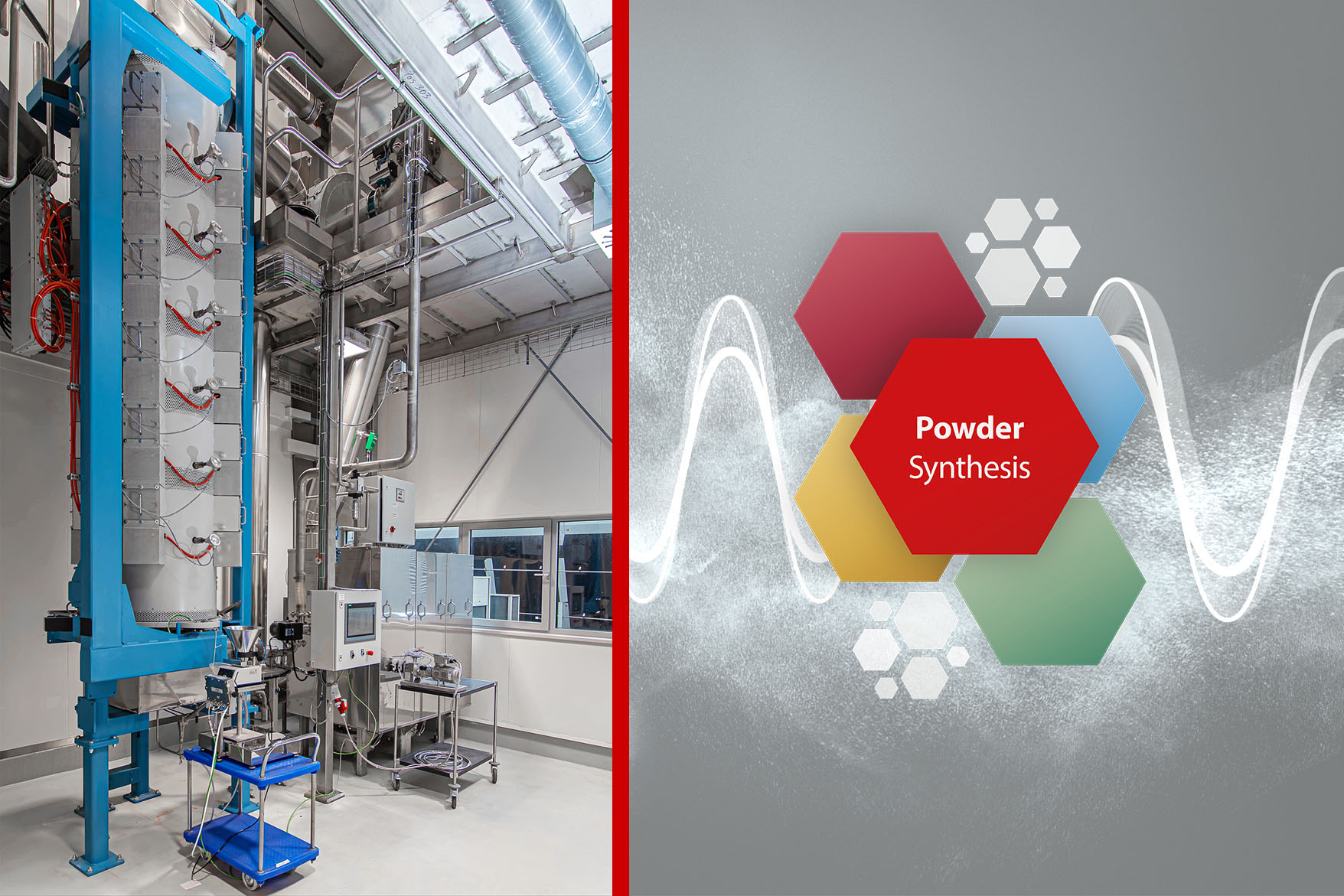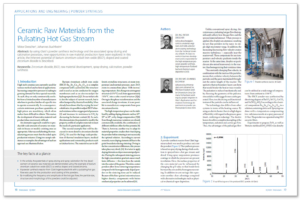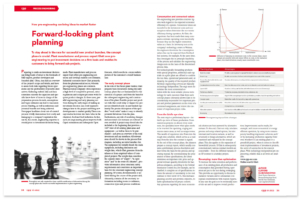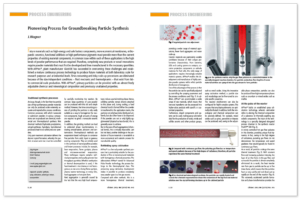New type of powder synthesis
Continuous process for manufacturing powders with customis-able properties
Whatever the field – medical engineering, battery technology or special pigments – companies looking to develop new applications for high-performance materials are dependent on new and innovative production technologies. A milestone in the produc-tion of customised powders has now been reached in Weimar, Germany.
- author: Manja Wühr, Editor, Vogel Business Media GmbH & Co. KG
- originally published in PROCESS Worldwide 05/2016, pages 46–48 (VOGEL Communications Group GmbH & Co. KG)
- keywords: spray pyrolysis, particle design, powder production, powder synthesis
The increasing demands being placed on the functionality and service life of components, equipment and machinery is a global phenomenon that constantly poses new challenges for the materials technology and materials development sectors. Advanced powders offer a means of achieving maximum functionality and outstanding performance. Despite significant innovation over the last few years, today’s powder manufacturers are specialised on a narrow range of materials. The range of standard products currently available effectively limits the performance achievable in technical applications. The type of customer-specific solutions needed for the latest high-performance materials demand technological solutions that are simply not available in many cases. The Process Technology Food, Feed & Fine Chemicals division at Glatt Ingenieurtechnik has developed its Advanced Pulse Powder Technology – a continuous, thermal process for generating powders. The special thermodynamic conditions within the APPtec® reactor enable the synthesis and configuration of innovative, high-performance powder materials that offer unique and previously unavailable combinations of properties. The chemical composition of the particles can be adjusted over a wide range, enabling the production of doped materials, materials with complex stoichiometries and coated particles.
Controlled particle formation
At the heart of the ProAPP® powder synthesis reactor is a specially designed combustion chamber that generates a pulsed hot-gas stream in which the particles are formed and processed. The frequency and amplitude of the pulsed gas stream can be adjusted, as can the process temperature and the flow speed. The synthesis reactor has been designed so that the pulsed gas stream can be controlled very precisely. The rapidly pulsing gas stream is housed within a stable and safe reactor. The pulsed gas stream creates an environment in which the rate of heat transfer from the hot gas to the particle is up to five times greater than in conventional systems. As a result, particle formation and phase transitions occur very much faster, leading to the formation of unique particle structures. The temperature and velocity gradients that are typical of systems employing continuous gas flows are not found in pulsed gas reactors due to the high degree of turbulence within the pulsed gas stream. The particles in the system therefore all experience the same temperature and the same residence time, resulting in powders that exhibit a high level of homogeneity.
Particle production begins when a fine spray of precursor solution is injected into the pulsed gas stream. The powders that begin to form from the droplets of precursor material are rapidly heated and undergo chemical and mineralogical reactions. At the end of the process, the particles are allowed to cool. As the process temperature can be carefully controlled at all times, the partial melting that can cause aggregation does not occur and the resulting powder product is free from aggregates (hard agglomerates). Other process parameters are:
- uniform process temperature between 200°C and 900 °C
- uniform residence time, adjustable from 100ms to 10 s
- adjustable gas atmosphere – oxidising or oxygen-free
- precursor: solutions, suspensions or solids.
From particle to plant
The APPtec® system also scores highly in terms of the efficiency with which these custom-produced, high-performance fine powders are synthesised. The new technology enables different process steps, such as drying and calcination or particle formation and particle coating, to be combined into a single step. And the process can be adapted very easily to meet customer requirements. Extensive in-house experience at Glatt means that test results can be translated immediately into full production without the need for a complex scale-up phase. Customers can decide whether they want to invest in their own APPtec® system or would prefer to make use of Glatt’s contract manufacturing services as it allows them to start supplying their product at the earliest opportunity. The close ties between the two divisions “Glatt Process Technology Food, Feed & Fine Chemicals” and “Glatt Process & Plant Engineering” guarantee that customers receive a fully integrated engineering solution.
Particle design is the name given to the process of developing, manufacturing, optimising and refining dry particulate solids such as powders, granules and pellets using the various Glatt technologies. Finding the right particle design is the job of the powder synthesis experts and the specialists in continuous fluidised bed and spouted bed technologies who work together at Glatt’s modern technology centre in Weimar. The project engineers from the Engineering department install plant machinery and entire manufacturing facilities. Glatt provides a full package of support services for customer investment projects covering initial consulting and advisory services, planning and execution that take customers from the initial concept through to a turnkey production system.
New applications
HIGH-PERFORMANCE POWDERS OPEN UP NEW MARKETS
With its APPtec® technology, Glatt now has the means to develop particle technology applications in areas not previously thought possible. The developers in Weimar are currently focused on four main areas: catalytic materials, powder materials for ceramics, pigments and food additives.
Catalytic materials:
The company has already demonstrated that its continuous pulsed gas stream process is particularly well suited for the manufacture of catalytic materials. The APPtec® methodology enables the catalytic activity of the powder surface to be controlled very precisely, which represents a major step forward in the manufacture of efficient catalysts.
Ceramic materials:
High-performance ceramics have frequently been combined with bioceramics, for example in joint endoprotheses or dental applications. Today, however, high-performance ceramics are finding far more widespread application in almost all key future markets, such as their use as cathode materials in fuel cells or as optical ceramics for lenses or detectors. Powder quality is of paramount importance in these applications. The APPtec process enables finely dispersed particles, targeted doping and outstanding homogeneity to be achieved with very high reproducibility.
Pigments:
While mass-produced products such as TiO2 or ZnO can be manufactured efficiently using established methods, there are significant limitations when it comes to fabricating specialist products, like effect pigments. Particularly finely dispersed pigments are often required in applications where improved colour strength or lower concentrations are needed. The pulsed hot-gas-stream technology from Glatt enables pigment powders to be synthesised with defined properties even at nanoscale dimensions.
Food additives:
Food additives need to easily metered so that the right quantities can be precisely added during the fully automated production of convenience foods. In food production, additives frequently have to exhibit specific functions, such as the ability to provide protection from external influences. The new powder synthesis technology from Glatt allows powders to be manufactured with precisely controlled characteristics and in accordance with the strictest quality standards.
Further information on this topic and related topics can also be found in the following publications:
Published article: ‘New Battery Material by Powder Synthesis’ PDF, English
Published article: ‘Ceramic Raw Materials from the Pulsating Hot Gas Stream’ PDF, English
Published article: ‘Glatt Powder Synthesis – Pioneering Process for Groundbreaking Particle Synthesis’ PDF, English







 Vereinigte Fachverlage GmbH
Vereinigte Fachverlage GmbH Copyright: Dr. Harnisch Verlagsgesellschaft mbH
Copyright: Dr. Harnisch Verlagsgesellschaft mbH